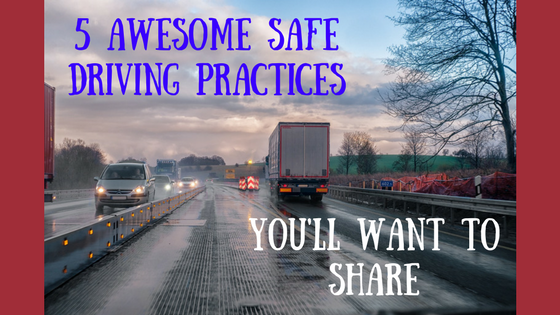5 Awesome Safe Driving Practices You’ll Want to Share
By : Admin -
Many Americans drive every day while on the job or during a commute. Over time, we don’t even think about the actions we perform while driving. It simply becomes second nature to us, and safe driving may take a backseat. However, transportation accidents continued to be the leading cause of work-related fatalities in the U.S. during 2016, according to the Bureau of Labor Statistics (BLR) National Census of Fatal Occupational Injuries.
In the BLR’s December 19, 2017 News Release, transportation-related injuries in 2016 accounted for 40% of total workplace fatalities, a 1.4% increase from 2015. Approximately 24% of total occupational fatalities during 2016 resulted from roadway incidents alone. Motor vehicle accidents are preventable. You can improve your employees’ awareness of safe driving by sharing the 5 following practices.
1 – Keep Vehicles Maintained, Including Safety Devices
Vehicles run and respond best when kept in optimal working condition. This includes all safety devices present on or within the vehicle. Share the items below with employees to promote greater mindfulness around vehicle maintenance.
-
Make sure all lights illuminate and are not obscured.
-
Keep mirrors & lights clean for best visibility.
-
Ensure the horn, signal lights, and hazard lights function properly to alert other drivers of your presence, lane changes, etc.
-
Stay on top of overall preventative vehicle maintenance, including tires, brakes, and steering system.
-
Have and regularly check your emergency roadside kit.
Best Practices: Include the above items on a mandatory pre-operational vehicle checklist. Strictly adhere to the manufacturers’ preventative maintenance schedule for vehicles.
2 – Maintain Focus When Driving by Avoiding Distractions
Distractions can bombard us while we are driving. It does not matter whether we are alone or in the car with others. Individuals can avoid distracted driving and keep their focus by implementing a few good habits:
- Don’t read or send texts while driving. Don’t talk unless it is handsfree.
- Refrain from performing personal tasks like putting on makeup, eating, drinking, etc. while behind the wheel.
- Avoid diverting your eyes from the road to switch radio stations/CD/DVDs or to use your navigational system.
- Steer clear of intense or loud interactions with other persons in the vehicle.
Best Practices: Put your phone out of sight while driving. Pull off and park your car if you need to text or talk. Take care of any personal grooming, eating, or drinking before you get behind the wheel. Program your navigation system before starting your trip. Use your steering wheel controls for the infotainment system so your gaze can stay on the road. Encourage passengers to keep conversations light, upbeat, and at an appropriate noise level.
3 – Seat Belts, Seat Belts, Seat Belts!
Did you know over 108,000 vehicle occupants (drivers and passengers) died in motor vehicle accidents between 2007 and 2016?1 Proper seat belt use greatly lowers the risk of fatal injury should an accident occur. Yet 15 states had seat belt usage rates less than 85% in 2016.2 Any employee awareness training on safe driving is incomplete if a discussion on seat belt use is missing.
- Make certain seat belts are in good working order.
- Ensure the number of occupants does not exceed the number of seat belts within the vehicle.
- Always wear your seat belt when the vehicle is moving. It is unlawful in many states to drive without wearing a seat belt.
Best Practices: Form a habit of buckling your seat belt before you start the vehicle’s engine. Keep the car in park until you have confirmed that all passengers have secured their belts.
4 – Drive Defensively and Keep Aggression in Check
Driving is really a team sport. You as a driver as trusting the drivers around you to operate their vehicles in a responsible manner, and they are expecting the same from you. However, some drivers do not always play well with others. This may lead to frustration and even anger in the other drivers sharing the road. The following defensive safe driving habits can help drivers avoid potential accident situations and keep their composure.
- Obey all traffic laws and use your signals, horns, and lights when appropriate to alert other drivers to your intended actions.
- Stay aware of others around you. Pay close attention to pedestrians, non-motorized vehicles, signals, speed changes, and reckless behaviors.
- Actively think about your next driving steps behind the wheel, including possible ways to avoid danger.
- Maintain a proper following distance from the vehicle in front of you. You never know when you may need that distance to stop your car.
- Keep your anger in check even when drivers around you are not driving courteously. Don’t let others poor behavior affect your safe driving habits.
Best Practices: Glance in your rear view, left side, and right side mirrors every 5-10 seconds. Maintain at least one car length in following distance for every 10 mph of speed your vehicle is traveling (60 mph = 6 car lengths). Larger vehicles should increase this distance, as they need greater distances to stop. Don’t drive when you are distressed; you may make unsafe driving decisions and/or experience unreasonable anger (i.e., road rage) in response to others poor driving.
5 – Watch Out for Impairments
You should have guessed by the other 4 safe driving practices covered in this post that driving should not be a passive activity. It requires alertness, active thinking, and focus. Your ability to drive safely is greatly affected when drugs, alcohol, or even fatigue is introduced into the situation. The following list can be utilized by workers as a quick refresher on impaired driving.
- Alcohol, illicit drugs, and driving do not mix. Any substance which may alter your perceptions should be avoided completely to stay safe behind the wheel.
- Be conscious of the precautions and instructions on prescription and over-the-counter (OTC) drugs.
- Don’t get behind the wheel when you are excessively tired or feel sleepy.
Best Practices: Practice zero tolerance for alcohol & drugs when you know you will be driving. Ensure you follow all instructions and adhere to all precautions of any prescription or OTC drug you may take. Drive only when you are well rested. Take periodic breaks to rest and stretch during lengthy trips. Avoid driving when you feel ill, as sickness may zap your energy and make it difficult to focus.
Safe driving is everyone’s responsibility. Promoting safe driving awareness serves as the key to keeping employees protected on the road. Want more safe driving information? Check out the resources below to learn more:
- Guidelines for Employers to Reduce Motor Vehicle Crashes – OSHA
- Safe Driving Practices for Employees – OSHA
- USDOT Federal Motor Carrier Safety Administration
- CDC National Institute for Occupational Safety & Health
1 Source: Centers for Disease Control and Prevention. WISQARS (Web-based Injury Statistics Query and Reporting System). Atlanta, GA: US Department of Health and Human Services, CDC; 2017. Available at https://www.cdc.gov/injury/wisqars/index.html. Accessed February 10, 2018.
2 Pickrell, T. (2017, May). Seat belt use in 2016-Use rates in the States and Territories (Traffic Safety Facts Crash●Stats. Report No. DOT HS 812 417). Washington, DC: National Highway Traffic Safety Administration.
Your feedback on this blog’s content is always encouraged. If you found this information useful, be sure to like, comment, and/or share below! You can also follow Prorsa Consulting on Google+, LinkedIn, Twitter, and Pinterest.

